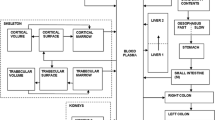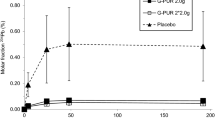Abstract
A study was undertaken to determine the fraction of ingested aluminium taken up by two male volunteers, following their ingestion of either aluminium citrate or aluminium hydroxide. In addition, the effects of simultaneous citrate ingestion on the gastrointestinal absorption of aluminium from its hydroxide was studied. Volunteers received three oral doses of26Al-labelled aluminium compound in water. The doses were administered directly into the stomach using a paediatric feeding tube. Blood samples were collected from the volunteers at 1, 4 and 24 h after administration, and their daily output of urine and faeces was collected for 6 days. These samples were analysed for their26Al content using either coincidence gamma-counting or accelerator mass spectrometry. The uptake of aluminium was greatest following its administration in the citrate form and was least following intake as the aluminium hydroxide suspension. The co-administration of citrate, with the aluminium hydroxide suspension, was found to enhance the levels of26Al uptake in both volunteers. Using a urinary excretion factor based on the results of previous studies, the fractional aluminium uptake from each of the species was calculated: aluminium citrate, 5.23 × 10−3; aluminium hydroxide, 1.04 × 10−4; aluminium hydroxide with citrate, 1.36 × 10−3.
Similar content being viewed by others
References
Barton JC. 1987 The absorption of metals as a function of age. In: Gerber GB, Métivier H, Smith H, eds.Age-related Factors in Radionuclide Metabolism and Dosimetry. Dordrecht: Martinus Nijhoff; 1–12.
Day JP, Barker J, Evans LJA,et al. 1991 Aluminium absorption studied by Al-26 tracer.Lancet 337, 1345.
Day JP, Lilley JS, Fifield LK,et al. 1994 Biological chemistry of aluminium studied using26Al and accelerator mass spectrometry.Nucl Instrum Methods Phys Res B92, 463–468.
DeBroe ME, van de Vyver F. 1985 Aluminium: a clinical problem in nephrology.Clin Nephrol 24, Suppl 1.
Doll R. 1993 Review: Alzheimers disease and environmental aluminium.Age and Aging 22, 138–153.
Edwardson JA, Moore PB, Ferrier IN,et al. 1993 Effect of silicon on gastrointestinal absorption of aluminium.Lancet 342, 211–212.
Ganrot PO. 1986 Metabolism and possible health effects of aluminium.Environ Health Perspect 65, 363–441.
Greger JL, Baier MJ. 1983 Excretion and retention of low or moderate levels of aluminium by human subjects.Food Chem Toxicol 21, 473–477.
Haram E-MR, Weberg R, Berstad A. 1987 Urinary excretion of aluminium after ingestion of sucralfate and an aluminium containing antacid in man.Scan J Gastroenterol 22, 615–618.
International Commission on Radiological Protection. 1981Publication 30. Ann ICRP 6, 2/3.
International Commission on Radiological Protection. 1991Publication 60. Ann ICRP 21, 1/3.
Métivier H, Fritsch P, Lataillade G. 1987 General considerations regarding intestinal absorption of radionuclides as a function of age. In: Gerber GB, Métivier H, Smith H, eds.Age-related Factors in Radionuclide Metabolism and Dosimetry. Dordrecht: Martinus Nijhoff; 13–20.
Partridge NA, Regnier FE, Reed WM,et al. 1992 Contribution of soluble aluminium species to absorption of aluminium from the rat gutin situ.Clin Sci 83, 425.
Priest ND, Newton D, Talbot RJ. 1991 Metabolism of aluminium-26 and gallium-67 in a volunteer following their injection as citrates. United Kingdom Atomic Energy Authority Report, AEA Technology,AEA-EE-0206.
Priest ND. 1993 The bioavailability and metabolism of aluminium in man.Proc Nutrit Soc 52, 231–240.
Priest ND. 1994 A human volunteer feeding study using aluminium-26 labelled aluminium citrate, aluminium hydroxide and aluminium hydroxide in the presence of citrate. United Kingdom Atomic Energy Authority Report, AEA Technology,AEA-TPD-268.
Priest ND, Newton D, Day JP, Talbot RJ, Warner AJ. 1995a Human metabolism of aluminium-26 and gallium-67 injected as citrates.Human Exp Toxicol 14, 287–293.
Priest ND, Talbot RJ, Austin JG. 1995b The bioavailability in young adults of aluminium ingested in drinking water. United Kingdom Atomic Energy Authority Report, AEA Technology,AEA-TPD-269.
Talbot RJ, Newton D, Priest ND, Austin JG, Day JP. 1995 Intersubject variability in the metabolism of aluminium following intravenous injection as citrate.Human Exp Toxicol 14, 595–599.
van de Vyver F, Visser WJ. 1990 Aluminium accumulation in bone. In Priest ND, van de Vyver F, eds.Trace Metals and Fluoride in Bones and Teeth. Boca Raton: CRC Press; 83.
Webert R, Berstad A. 1986 Gastrointestinal absorption of aluminium from single doses of aluminium containing antacids in man.Eur J Clin Invest 16, 428–432.
Wilhelm M, Jäger E, Ohnesorge FK. 1990 Aluminium toxicokinetics.Pharmacol Toxicol 66, 4–9.
World Health Organization. 1972The Use of Ionizing Radiation in Humans for Medical Research and Training, Including the Use of Radioactive Materials. Geneva: WHO.
Author information
Authors and Affiliations
Rights and permissions
About this article
Cite this article
Priest, N.D., Talbot, R.J., Austin, J.G. et al. The bioavailability of26Al-labelled aluminium citrate and aluminium hydroxide in volunteers. Biometals 9, 221–228 (1996). https://doi.org/10.1007/BF00817919
Received:
Accepted:
Issue Date:
DOI: https://doi.org/10.1007/BF00817919




